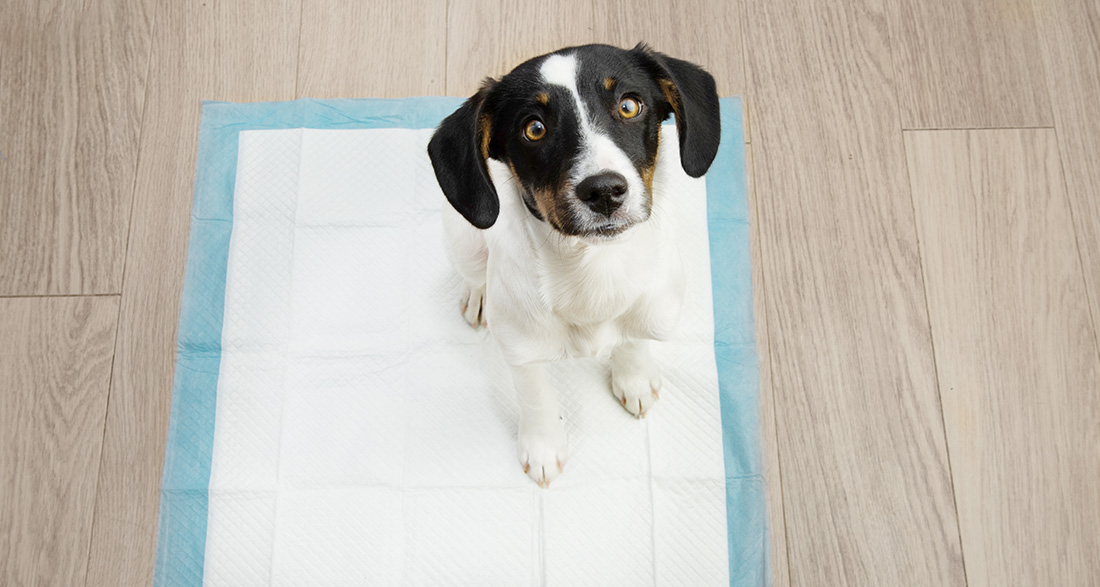Potty training a new puppy can be challenging if you’re unsure of what to do. However, there are several tools that can help you teach your puppy to use the bathroom where you want it to. Using potty pads (also known as puppy pads) is one way to train your puppy where it’s appropriate to go. Consistency is key to this training method, which can also be used to teach your puppy to potty outdoors.
Choosing a Potty Pad
The idea behind a potty pad is to create a visible, consistent area for your puppy to potty. You should choose something that is absorbent, easy to clean, and large enough for your puppy’s messes. Large breed dogs may require heavier options compared to toy breeds. Newspapers, paper towels, cloth towels, and store-bought pee pads or carpet squares for indoor and outdoor use are all options.
Newspapers and paper towels may be messy and challenging to clean after puppy potty, but they are cost-effective. Cloth towels are absorbent but need regular washing, and your puppy may be tempted to chew on them like a blanket or toy. Store-bought pee pads are the most popular option due to their absorbency, size options, and easy disposal. If you plan to train your small dog for indoor potty use, indoor and outdoor carpet potty pads specifically designed for dogs are a good choice.
Introduce Your Puppy to the Potty Pad
Let your puppy see and sniff the potty pads you have chosen. This helps it get used to the new object, so it won’t be fearful when it’s time to use the pad. Allow your puppy to walk on the pad while repeating a consistent command you want to associate with potty time, such as “go potty.”
Anticipate When Your Puppy Will Potty
When training your puppy to use the potty pad, keep it close so you can anticipate when it’s about to go. There are a few key times and behaviors to watch for to expect when your puppy may need to urinate or defecate:
- Puppies typically go after sleeping, eating, drinking, and playing. After your puppy does any of these activities, pick it up about 15 minutes later and place it on the potty pad, expecting it to pee or poop.
- If your puppy starts sniffing around the floor instead of playing with a toy or chewing, it’s a good indication that it needs to potty. When this happens, pick it up and place it on the potty pad.
- Your puppy may need to potty every two to three hours. Get into the habit of taking your puppy to the potty pad every few hours.
Reward Your Puppy
Praise and treats work wonders with puppies. When your puppy potters on its potty pad, immediately praise it. This can be verbal, in an excited tone, by petting your puppy, or by giving it a special, soft treat reserved for potty time.
Be Consistent
Regularly take your puppy to the potty pad. This helps you predict when your puppy might need to potty.
Use the same command phrase every time.
Keep the potty pad in the same location until your puppy goes to the pad on its own. Once your puppy knows what to do on the potty pad, you can slowly move it closer to the door or outside, where you want your puppy to use the bathroom without the potty pad.
Avoid Training Mistakes
Don’t encourage your puppy to pull or chew on the potty pad, eat it, or play with it. This can confuse your puppy about the purpose of the potty pad.
Don’t move the potty pad until your puppy understands its purpose and consistently uses it.
Make sure to find and use a treat that truly excites your puppy. This will help in the training process.
Addressing Problems and Proofing Behavior
If your puppy doesn’t make it to the potty pad in time, try bringing it closer to where it usually plays or eats, then gradually move it closer to the door if you want to train it to potty outside.
If you have trouble keeping an eye on your puppy, and accidents happen when you’re not looking, try these strategies:
- Add a bell to the collar so you can hear where it is.
- Leave the leash on so the puppy can leave a trail behind it, giving you a clue.
- Consider putting your puppy in a crate or playpen for a nap. This may prompt it to whine when it needs to potty, as dogs typically don’t like to sleep where they pee.
If your puppy seems to be constantly urinating, consult your veterinarian for possible issues known to affect some puppies.


